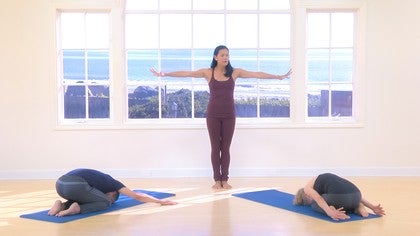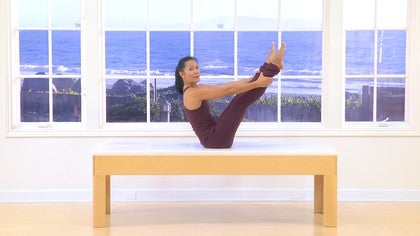Description
About This Video
Transcript
Read Full Transcript
Hi, I'm blossom. Laelani Crawford. I wanted to talk to you about Cathy Song. Kathy Song was the heart of Kathy's work the first time that I had to go and teach at a conference for her. She made me come over to her house and we discussed what she wanted me to teach for her. And she was like, the first thing was like, don't forget the song. And the song is really, I mean, I use the song all the time and I really want to share this with you because it's very important in dumb. It's wordy, it's a lot. Some people I know this woman, she goes, well, I kind of think of it more as a poem and I was like, yeah, poem sounds good. Um, it's lengthy. It's not, it's not easy to say, but it's totally worthwhile.
There are alignment and sort of visualizations for sitting up tall and getting yourself into center. So the first one is, um, in the song is to zip tight jeans on. And why I describe it. I say not the cute little jeans where the Zipper is the only this big, it's the 1970s mom jeans, right? So or the really cute ones without the liker that you had to lie down to get into. So you zip tight jeans on some pubic bone all the way to the navel. That's the first one.
Next one is belly button to the lowest part of the waistline. I'm going to say that again, belly button to the lowest part of the waistline. I'm going to come back to that. Next one is put a belt on and it's amazing to me how many times people go, what does that mean? And it's simply this, when you go to put on a belt and you're looking down, you're like, Ooh, I might get to the next notch. And that motion, that movement, and you have to do to kind of like see if you can get to the next notch. That's what that is. And if I were to verbalize it and be technical, I would say it's your rib cage lengthening up away from your pelvis while narrowing in the waist. Put a belt on. Next one, put a vest on.
And the best one I have to say was what are the most mysterious ones for me? And kind of still is. But this always resonated with me. Kathy would say, you know, my husband, when he puts on a suit and he puts out, you know, he puts on the pants and he's got all, he's got this big stomach, but when he puts his vest on, it's so he really just pulls it and look so elegant. And so I think of it as sort of a, a feeling of elegance. And then the last one is tape measure my like, I'm going to go to my grave and it's going to say tape measure on it from, you know, from Kathy. So tape measure is if you've ever been fitted for a costume or a dress, they measure your hips, they measure your waist, and they go right underneath your breasts right here.
And so as a young dancer when I used to stand and someone would say, stand up straight, I would do this because it feels like I was taller. But what I'm really doing is throwing my rib cage out. And so tape measure is the idea of being measured for that costume or dress and you're thinking, I want that shirt to be nice and tight. I can't go back. I can't go forward. I can't go anywhere but in, and that's tape. The last one is a, she'd say it's like Dorothy going off to never, never land, which, you know, mixed metaphor a little bit. But uh, so it's that idea of lengthening up, up, up forever and ever and ever and ever and just had an idea of lifting, lifting, lifting, lifting. So again, zip tight jeans on belly button to the lowest part of the waistline.
Put a belt on, vest, tape measure and fly. Fly, fly, fly, fly. So let's go to the most complicated one. Belly button to the lowest part of the waistline. Um, so the story goes like this, Kathy, when I would visit her a visit when I was working with her. So if I was, when I was working with Kathy for over 10 years at NYU, um, every morning you would walk in and you would pick up the calendar cause it fell off. The wall was held in with a push pin on the wall and the calendar, you'd pick it up, put the calendar back up and right next to the calendar was another picture that was held in with a picture hook and you don't have the picture hook when you nail it in, it goes in on that beautiful diagonal. And this is around the era of neutral pelvis. Neutral pelvis was this sort of like thing that people were talking about for awhile where they'd say it became code for what kind of polarities teacher you were. So if you were one kind of politesse teacher, you would practice neutral pelvis and it was a new term and Cathy would be like, what is a neutral pelvis? People would come to her and she'd be like, do you, do you know what your neutral pelvis is? You know what that is? Can you show me what that is?
And so she kept wondering like what is neutral pelvis and trying to struggle with the, what Mr Plot is used to say, which was navel to spine. And what we learned from physical therapists and anatomy is that you actually should not remove the curve of your spine. You actually need the curve of your spine. But she didn't want to say that Mr plots was wrong. And so she's one day sitting, she would sit at her little desk and she's looking at the calendar and she had this sort of like a god moment and she thought well maybe, maybe the pushpin is navel to spine, just straight back.
She sometimes mix it up and save, call it the power punch as opposed to powerhouse. She would say power punch cause it's if you brought your naval straight back and then while she's like maybe the pushpin is navel to spine, but maybe I want belly button to the lowest part of the waistline. And for me, the way I translate that myself is I think of an internal connection between my naval and the lowest part of my waist. And I lift the front of my body and drop my tail ever so slightly and connect the two on the inside. That's my interpretation. Kathy would say, you know, it's that feeling of a contour about like women remember how we, um, those contour belts, how they'd sit in your hips and how low the wasteland lessened, how comfortable that was.
She talked about how that sort of made sense for women. But let's also show this with a man, cause this is when it got interesting. So I'm going to bring in, um, Jim Monroe and a man just qualified. I'm the woman. Yes. So he's going to do point to hit, have one finger on his naval [inaudible] and the other finger actually goes this way on his, you know, the up profile on his waistline. So naval to waistline, right. And look at the distance between his navel and his wasteland here. So really give it just a finger. Yeah, there you go. So that he, they can see the point. And if you look at that, the difference in height from his navel to his waistline is almost even ish.
Here's mine, navel to waistline. And hopefully you can tell that my waistline back here is lower women's pelvises are different from men. Yeah. So let me keep going. Thank you Joe Nelson. So Kathy would say Mr [inaudible] was a man and for him navel to spine worked and if it works for you, then do naval the spine. If it doesn't work, try belly button to the lowest part of the waistline. So the song is lovely, right? It's really great cues. It's really fun, but it doesn't mean anything unless you can use it in context.
So let me just do a very simple a sit up or lying down and Kathy would say, and this is what I really, she would say, it's a three part harmony. You're breathing, you're articulating your spine and you're singing my song three part harmony. So as I go down, I think zip tight jeans on belly button to the lowest part of the waistline. I'm not even there yet. Almost there, put a belt on vest. And especially when I go to lie down, I'm gonna keep my tape measure on cause I want to do this.
There's my tape measure and even sitting up tape measure vest belt belly button to the lowest part of the waistline. And here it is zipping, zipping, zipping, zipping, nothing enough. Now you've got to think about the songs that you could also take the song and piecemeal it. So for instance, open leg rocker, uh, let's see. So here's open leg rocker. I, if I'm down here, see how I'm kind of hanging out on my waistline, I would tell someone to put a belt on. And if I'm belting you hopefully see the lift of the rib cage. And for me it's always tape measure.
So sometimes Kathy would say belt and tape measure or zip and tape measure. But it was always tape measure. But you can kind of piecemeal the song and not just, you don't have to sing the whole song. But sometimes when I'm have someone doing a movement and I just want a little more ribcage connections, I'll just say tape measure. Or if I want to lengthen the spine, I'll say put a belt on. And so again, it's like Kathy used to say Aye. She was a short order cook.
It was a quick way for her to get to a line, one part of your body. So she said tape measure. To me, I knew it was my rib cage. If she said belt to me, I knew to lift up, it's a much easier, faster way than saying blossom, lift up out of the hips if she, all she had to say was belt as she walked by and then she was done. So these are great little cues and just a thing that was really the heart of her work. And she always would say to me, she would always say, sing my song. And I think that not just literally, but also sort of figuratively, like this was this incredible beautiful woman that I just loved. And I really hope that you sort of get to see a part of that, not the love part, which I obviously have for her as you can tell as I'm going to weep right here on camera. But that this song is really sort of, was really just about coming from the inside and that when you do this great, intelligent work that you are coming from the inside.
So if you're singing her song, you're working it the right way. Have Fun guys.
Pilates Legacy Project: Kathy Grant Methods
Comments
you've such a powerful, enthusiastic and moving way to share.
You need to be a subscriber to post a comment.
Please Log In or Create an Account to start your free trial.





































